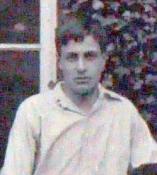
War Memorial
| Captain Charles Norman Cavendish BOYLE MC | |
|
1st Battalion Rifle Brigade attached to the 13th (Service) Battalion Date of birth: 19th September 1890 Date of death: 10th June 1961 Died aged 70 Unknown |

|
| Charles Norman Cavendish Boyle was born at New Rochelle, New York on the 19th of September 1890 the only son of William Lewis Boyle MP, Member of Parliament for Mid Norfolk, and Charlotte Mary (nee Norman) Boyle of Tuddenham Lodge , Honingham near Norwich. He was educated at Hazelwood School until July 1903 where he was a member of the Choir and a member of the Football XI in 1902 and a member of the Cricket XI in 1903. The school magazine wrote the following on his 1902 football season: - "(Centre half) - A splendid tackler; has improved immensely in "feeding" his forwards and passing to his backs. A poor shot." They wrote of his 1903 cricket season: - "Another boy with the word forbidden by Napoleon, which has interfered sadly with his batting. A good field and a fine thrower from the country." On leaving the school the magazine wrote of him: - "....goes to complete his preparation for the Royal Navy at Stubbington. he has been a conspicuous figure in the two Elevens, at the athletic sports, in the choir and on the stage." He went on to Stubbington House School but, deciding against a career in the Navy, he went instead to Charterhouse School where he was in Weekites House from January 1905 until July 1908 after which he attended Wye Agricultural College. He was commissioned as a probationary 2nd Lieutenant in the Rifle Brigade (Special Reserve) on the 1st of March 1915 and joined the 5th Battalion at Sheppey. He soon transferred to the 1st Battalion, landed in France on the 27th of May 1915 and was in action with them at Boesinghe in the Ypres sector on the 6th of July 1915 when he was wounded. Major C.F.C. Letts wrote:- “I served with Charles Boyle first in the C.O.U.T.C. (or perhaps I should call it "Combers Corp's") and then in the 1st Battalion in the action of July 6th, 1915, the platoon I commanded was detailed to go through the German Trench when captured, and dig a sort of Switch Trench beyond it. When I arrived on the parapet of the German trench, the first person I saw was Charles, waving a rifle with fixed sword, hatless, and bleeding from a slight wound in the face, and looking just like one of the recruiting posters then so common. He asked me to reinforce his men, as he thought he had not enough men left to hold the trench. This I did, with the result that my platoon got well mixed up with his, and later on, I had to extricate them personally before I could get enough men to do the digging job. I think he was the only surviving officer of the attacking party, and took entire charge of the situation till relieved by Gasson ("I" Company), when he was sent back to the Casualty Clearing Station. He rejoined in a day or two as his wound was not serious.” According to the regimental history he was awarded the Military Cross for this action although the notice did not appear in the London Gazette until the 14th of January 1916. He was confirmed in the rank of 2nd Lieutenant on the 21st of July 1915 and was promoted to Captain on the 31st of July 1917. After a short period at home with the 5th Battalion he was attached to the 13th Battalion which he commanded for a brief period during the Battle of the Scarpe in April 1917. He was twice mentioned in despatches and was appointed as an Aide-de-Camp on the 5th of March 1919. He was promoted to Captain on the 13th of November 1921. He was married at the Holy Trinity Church, Brompton to Margaret Constance Nevile (nee Lubbock, formerly Hambro), the widow of Bertram Emil Hambro, at the Holy Trinity Church, Brompton on the 15th of May 1919; they lived at Brook Street, Edenbridge in Kent. He worked as an insurance manger and later moved to Liverpool Colonel J.S. Wilson, CMG OBE (formerly Chief International Scout) wrote:- “Charles Boyle entered the scout movement in 1932 as a very enthusiastic and valuable member. He was a Rover Scout Leader and Group Scoutmaster in Kent and almost immediately became a member of the County Training Team, which was responsible for both the elementary and advanced training of Scout Officers. In 1936 he was attached in a similar capacity to the International Scout Training Centre at Gilwell Park and a voluntary helper on many courses there. His knowledge of various aspects of Scoutcraft learned in the Army and in Egypt, but founded on his own natural inclination and abilities, was of great value. His cheerfulness and good nature helped and charmed the many foreign Scouters who came to Gilwell from all parts of the world.” He became a member of the Council of the Boy Scout's Association and of its Executive Committee in 1939, resigning from the latter in 1941 because of his wartime duties, and from the former in 1959. He was also the Headquarters Commissioner of the Wolf Cub Section of the Association from 1938 to 1942. In addition, he held warrants as District Commissioner or Assistant County Commissioner in Essex, Buckingham and Wiltshire from 1942 until his death. "His influence on Scouting was considerable and in this sparetime activity of his he brought cheerfulness and determination to many thousands of boys and men.” On the outbreak of war, he re-joined the service and was appointed as a Censor at the War Office.He was released from the Reserve of Officers due to his age on the 19th of September 1940 but later re-joined the army and was appointed as a 2nd Lieutenant in the Intelligence Corps on the 8th of December 1942. He was promoted to Captain on the 22nd of July 1943 and to temporary Major on the same date. He spent the war years on censorship duties in England, Africa, Italy and Austria, being promoted to Major (General Staff Officer Grade 2) on the 31st of May, 1944, and to Lieutenant Colonel (General Staff Officer Grade 1-Austria) on the 4th of August, 1945. He was awarded the American Legion of Merit on the 4th of April 1946 and was mentioned by the King for “gallant and distinguished services in the Mediterranean Theatre” on the 23rd of May 1946. He was released from the service in 1948. He died at his home, Pythouse Cottage, Tisbury in Wiltshire after a long illness. |
|
| Went on to Charterhouse School |
Back